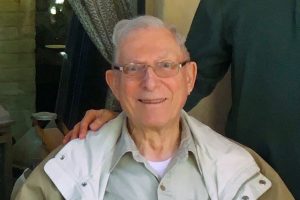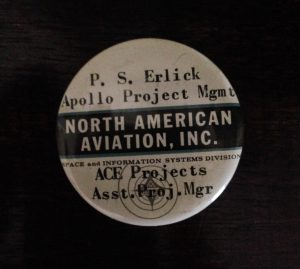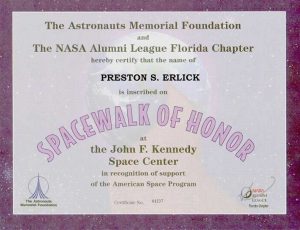Preston S. Erlick
Jun 29, 1923 – Oct 16, 2020 | Phoenix
PROGRAMS:

COMPANIES:
LOCATIONS:
Downey, CA
POSITIONS:
Project Manager for The Mechanical Man proposal
and Assistant Project Manager of the Automatic Check-out Equipment (ACE) for the Apollo Command Module (CM)
COMMENTS:

Pat Erlick, 50 years after Apollo, in July 2019
In his 45-year storied career, Pat Erlick worked for 13 aerospace companies. During the First Space Age, Pat worked at North American Aviation on the Apollo program on the Command & Service Module (CSM), Block I which would be used for early testing. The Block I design was focused on the guidance and navigation equipment in support of the first earth orbital flights, with in-flight fault diagnosis and repair.
“The primary objective of Apollo 11 was to complete a national goal set by President John F. Kennedy on May 25, 1961: perform a crewed lunar landing and return to Earth,” the NASA website states. Leading into the success of Apollo 11, there were numbers of other activities and testing that needed to be verified for operability and safety, before the first crewed flight to the moon. This validation phase on the Apollo Program during the First Space Age is where Pat’s contribution with the Mechanical Man Proposal helped bring us closer to the first landing on the moon with Apollo 11.
Pat’s task for the Apollo Space Program was the proposal for The Mechanical Man (or in today’s terms, automation: without modern computers, as we know them today). The spacecraft had to work and test the environment before crew members could be placed into the module. There had to be a way to automate spacecraft operations, without a person, to validate the operations. The requirements were to have two spacecraft successfully complete their flights, with the S-IVB 3rd Stage (on Apollo 4 and Apollo 6). This would pave the way to the first manned flight on the Saturn V (Apollo 7), and eventuality of the Apollo 11 first landing on the moon. Pat was working for David Levine, manager for Electrical and Electronics Systems for the Apollo Command and Service Module (CSM), at North American, when he was asked to be the project manager for the Mechanical Man Proposal (or the mission control programmer).
The Mechanical Man was utilized to initiate/react to those in-flight actions that would normally have been provided by the flight crew. This included stabilization of spacecraft; navigation relative to the moon, sun and the stars; electrical power systems and battery charging; communications and instrumentation; environmental control systems; reaction control systems, service propulsion systems; and in-flight system check. In other words, it was the automation of the Apollo spacecraft in preparation for its first flight with the S-IVB (Saturn IV Booster, 3rd Stage) on the Saturn V vehicle (AS-501), in preparation for the flights to the moon.
As quoted from December 1963, in the proposal, “The Mechanical Man is conceived for the purpose of performing certain specified functions which will allow an Apollo spacecraft sent into earth orbit to perform a planned flight or abort if necessary to a prescribed landing area, and be recovered.” Continuing from the proposal “Only functions essential to assuring the survival and return of an astronaut from launch to recovery are considered as necessary to be implemented by the Mechanical Man.”
At the completion of the proposal, Pat was sent from Downey, California to Houston, Texas to present the proposal to Dr. Joseph F. Shea, NASA’s Manager of the Apollo Spacecraft Program Office (ASPO). Dr. Shea had the responsibility for managing the design and construction of the Apollo Command and Lunar Modules, with oversight of North American Aviation (NAA), the contractor.
After NASA’s approval of the proposal, NAA implemented the Mechanical Man in the Command Module. Following this, Pat Erlick received a commendation from Norman J. Ryker, Chief Engineer (and a major spokesman for the Apollo program) of Vehicle Systems at NAA, in Downey. Years later, with the Mechanical Man in the Command Module, results were the validation of all required test points during successful flights on Apollo 4 (November 1967) and Apollo 6 (April 1968).
Following the Mechanical Man proposal role, in 1964, Pat took on a different role for the Apollo program. This time as the assistant project manager of the Automatic Check-out Equipment (ACE Projects) for the Apollo Command Module, under Ray Larson at NAA.
Subsequent to Pat’s roles at North American Aviation, and his initial support to the beginnings of the Apollo program, he continued on with Hughes now working on the Surveyor Program. This program became the precursor to the “path to the moon.”
Pat’s roles for the Apollo program, are but one person’s example of the 400,000 engineers, scientists, and technicians on the Apollo Space Program from more than 20,000 companies and universities, to help contribute and create something quite spectacular. A lot of accolades went to those brave astronauts; extremely well deserved as they risked their lives for their country and the world. In addition, honors should also go to the thousands of engineers, scientists, and technicians who designed and tested – from pure imagination and previously unavailable technology – the safe systems that helped to take these brave men to the moon and return them safely to earth!

P.S. Erlick button

1998 Pat Erlick Certificate of Inscription







